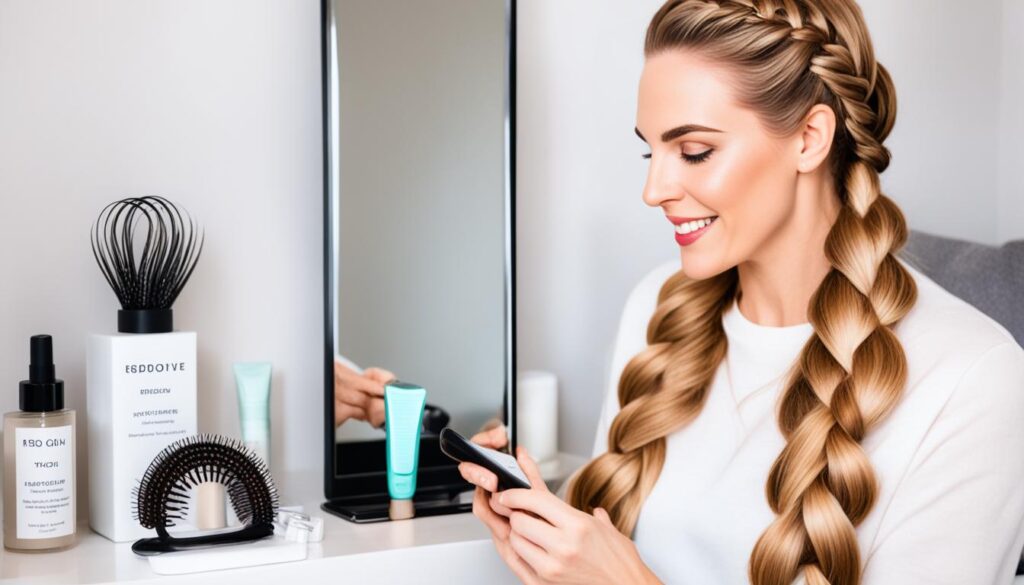
Have you ever wondered if your hair could magically grow overnight? While that might sound like wishful thinking, there is a hair care routine involving braiding that claims to promote hair growth. But is it really true? Will your hair actually grow if you sleep in braids?
Before we unveil the truth, let’s explore the benefits of sleeping in braids as part of your hair care routine. Braiding your hair at night can help prevent tangling and knotting, reduce hair breakage, and maintain hair hydration. It’s also a convenient way to keep your hair out of your face while you sleep, preventing unwanted acne breakouts.
Now, the burning question: Does sleeping in braids directly lead to hair growth? To find out, we’ll delve deeper into the do’s and don’ts of braiding hair and examine the impact of braiding on your hair’s overall health. So keep reading to uncover the truth and discover the secrets to maintaining healthy and beautiful hair.
Key Takeaways:
- Braiding your hair at night can prevent tangling, reduce breakage, and keep your hair hydrated.
- Braiding alone doesn’t make your hair grow, but it can create an environment that promotes hair growth.
- Follow proper braiding techniques and take care of your hair and scalp to ensure optimal results.
- Sleeping in braids can prevent acne breakouts by keeping your hair off your face.
- The ritual of braiding hair holds cultural significance and serves as a bonding experience in many cultures.
The Benefits of Braiding Hair at Night
Braiding your hair at night offers several advantages that contribute to healthier hair and easier styling. By preventing tangling and knotting, reducing hair breakage, maintaining hair hydration, and promoting hair growth, braiding serves as a valuable addition to your bedtime hair care routine. Additionally, braiding keeps your hair out of the face, providing a comfortable and acne-free sleeping experience.
When you braid your hair before bed, you minimize the risk of tangling and knotting, saving time and effort in the morning. As your hair remains neatly braided overnight, you can avoid the frustration of untangling pesky knots and snarls, ensuring a smooth and hassle-free start to your day.
Braiding hair also effectively reduces hair breakage by minimizing friction between your hair and the pillow. Instead of your strands rubbing against the fabric during sleep, the braid acts as a protective barrier, safeguarding your hair from unnecessary damage. This benefit is especially significant for individuals with fragile or brittle hair.
Furthermore, braiding helps maintain hair hydration by locking in moisture. The braid helps seal the hair cuticles, preventing excess moisture loss while you sleep. This is particularly advantageous for individuals with dry hair, as it helps retain essential moisture levels, promoting overall hair health and preventing further dehydration.
While braiding itself does not directly stimulate hair growth, it creates a favorable environment for it to thrive. By preventing damage and maintaining hair health, braiding sets the stage for optimal hair growth. Consistently adopting this practice can contribute to the long-term growth and vitality of your hair.
Another benefit of sleeping in braids is the convenient styling they provide in the morning. When you unravel your braids, you often wake up with naturally wavy hair, eliminating the need for additional heat styling or curling irons. This effortless wave adds a touch of volume and dimension to your hair, enhancing your overall look with minimal effort.
Last but not least, braiding your hair at night keeps it out of your face, preventing acne breakouts. By securing your hair away from your forehead and cheeks, you minimize the transfer of oils and impurities that can contribute to clogged pores and subsequent breakouts. This is particularly beneficial for individuals with oily or acne-prone skin.
Tips for Braiding Hair Before Bedtime
When it comes to braiding your hair before bed, following a few essential tips can help you achieve beautiful, healthy hair. Whether you want to prevent tangles, protect your hair, or simply try different braiding styles, these tips will ensure that your bedtime braids are beneficial. Here are some expert-recommended practices to keep in mind:
Start with Detangled Hair
Before you begin braiding, it’s crucial to start with thoroughly detangled hair. This not only makes the braiding process smoother but also helps prevent unnecessary hair damage. Gently comb through your hair with a wide-toothed comb or a brush designed specifically for detangling before starting your braids.
Use Nourishing Hair Products
To keep your hair moisturized and healthy, consider using nourishing hair products before braiding. Apply a leave-in conditioner or a light hair oil to help retain moisture and add shine to your braids. This step will ensure that your hair remains hydrated overnight, minimizing the risk of dryness and breakage.
Braid Gently
When braiding your hair, it’s essential to be gentle to avoid hair breakage and scalp pain. Take your time and use soft, smooth movements while weaving your strands. Being patient and mindful during the braiding process will help maintain the integrity of your hair, allowing it to grow and thrive.
Secure with a Soft Hair Tie
To prevent hair breakage and tension on your scalp, secure your braids with a soft hair tie or scrunchie. Avoid using tight rubber bands or accessories with metal parts, as they can cause damage to your hair. Opt for gentle, fabric-based hair accessories that won’t snag or pull on your braids.
Try Different Braiding Styles
Experimenting with different braiding styles is not only fun but also beneficial for your hair. Trying out various braids, such as French braids, Dutch braids, or fishtail braids, can distribute tension and strain differently across your scalp and hair strands. This variation helps prevent hair breakage and allows different sections of your hair to rest between styles.
Protect Your Braids at Night
When you sleep, your hair can easily become tangled or frizzy, leading to potential damage. Protect your braids at night by using a silk bonnet, scarf, or pillowcase. These materials create a smooth surface for your hair, reducing friction and helping to maintain the integrity of your braids.
Don’t Braid Wet Hair
Braiding wet hair can increase the risk of fungal infections and hair damage. It’s best to let your hair dry partially or completely before braiding it to ensure the health of your hair and scalp. If you’re short on time, you can use a blow dryer with a diffuser attachment to speed up the drying process before braiding.
Don’t Over-Tighten
Avoid over-tightening your braids as it can put stress on your hair and scalp. Tight braids can cause hair breakage, traction alopecia, or even headaches. Opt for a comfortable and secure tension level when braiding to maintain the health of your hair and scalp.
Don’t Leave Braids in Too Long
While braids can be a protective style, leaving them in for too long can lead to tangling and matting of the hair. Aim to keep your braids in for a maximum of six to eight weeks to prevent unnecessary damage and promote healthy hair growth.
Don’t Use the Same Style Continuously
Repeatedly wearing the same braiding style can strain specific areas of your scalp and lead to breakage. To distribute tension evenly and promote overall hair health, switch up your braiding styles frequently. Give different parts of your hair a break by trying new braid patterns and alternating the position and size of your braids.
Don’t Neglect Hair and Scalp Health
While braiding your hair can be a convenient and protective style, don’t neglect the overall health of your hair and scalp. Regularly condition your hair, trim split ends, and cleanse your scalp to maintain optimal hair health. Take care of your hair even when it’s in braids to ensure its strength and vitality.
By following these tips, you can enjoy the benefits of braiding your hair before bed while maintaining healthy, beautiful locks. Remember to start with detangled hair, use nourishing hair products, braid gently, and secure your braids with a soft hair tie. Experiment with different braiding styles, protect your braids at night, and avoid braiding wet hair or over-tightening. Additionally, vary your braid styles and prioritize hair and scalp health. With these practices in mind, you’ll master the art of bedtime braiding and promote the overall well-being of your hair.

| Braiding Tips | Do’s | Don’ts |
|---|---|---|
| Start with detangled hair |
|
|
| Use nourishing hair products |
|
|
| Braid gently |
|
|
| Secure with a soft hair tie |
|
|
| Try different braiding styles |
|
|
| Protect your braids at night |
|
|
| Don’t braid wet hair |
|
|
| Don’t over-tighten |
|
|
| Don’t leave braids in too long |
|
|
| Don’t use the same style continuously |
|
|
| Don’t neglect hair and scalp health |
|
|
The Ritual of Braiding Hair in Different Cultures
Braiding hair holds cultural significance and is a form of bonding in many different cultures. In Indian culture, braiding hair is seen as an important and healthy practice, passed down from generation to generation. It is a way for mothers to protect their daughters’ hair and create a special bond through the ritual of braiding. Many other cultures also have hair braiding rituals that serve as a time of connection and care.

One example of a hair braiding ritual is found in African cultures, where intricate braided hairstyles are created as a means of cultural expression and identity. Braiding sessions become a bonding time between mothers, grandmothers, and daughters, passing down traditions and stories while creating beautiful hairstyles. The process itself can be a meditative and communal experience.
“Braiding hair is not just about creating beautiful hairstyles, but it also represents our heritage, identity, and connection to our ancestors. It’s a way for us to celebrate and honor our culture.”
– Name Surname, cultural anthropologist
Similarly, in Native American cultures, braiding hair is deeply rooted in tradition and spirituality. The act of braiding is seen as a way to strengthen the connection between the physical and spiritual realms. Native American tribes often incorporate feathers, beads, and other meaningful symbols into their braided hairstyles as a way to honor their cultural heritage.
Braiding hair has also been a long-standing tradition in many Asian cultures, such as Japan and China. Intricate braided hairstyles, such as the Chinese “Liangdian” and the Japanese “Shimada,” have been passed down for generations, symbolizing beauty, femininity, and marital status. These hairstyles are often seen during special occasions, such as weddings and ceremonial events.
Overall, hair braiding rituals serve as a time for bonding, creativity, and cultural preservation. They provide an opportunity for generations to come together and share stories, traditions, and techniques. Beyond their aesthetic appeal, braided hairstyles have a deep cultural significance and demonstrate the importance of hair protection and care in various communities.
Conclusion
Braiding your hair before bed can be a valuable addition to your hair care routine, offering numerous benefits for healthy hair growth and overall hair health. By following this bedtime hair care ritual, you can prevent tangling and reduce hair breakage, helping your hair to thrive.
The act of braiding your hair helps maintain its hydration and promotes hair growth, providing an easy styling option in the morning. Furthermore, keeping your hair out of your face while you sleep can prevent acne breakouts, contributing to clear and radiant skin.
To maximize the benefits of braiding, remember to braid gently, starting with detangled hair, and secure your braids with a soft hair tie. It is also crucial to protect your braids at night by using a silk bonnet, scarf, or pillowcase to reduce friction.
Embrace the ritual of braiding, not only for its hair benefits but also as a special bonding time with loved ones. By caring for your hair and following a consistent bedtime hair care routine, you can support healthy hair growth and maintain beautiful and manageable locks.






